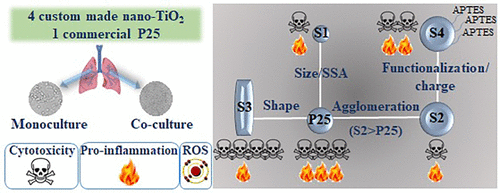当前位置:
X-MOL 学术
›
Chem. Res. Toxicol.
›
论文详情
Our official English website, www.x-mol.net, welcomes your
feedback! (Note: you will need to create a separate account there.)
Impact of the Physicochemical Features of TiO2 Nanoparticles on Their In Vitro Toxicity.
Chemical Research in Toxicology ( IF 3.7 ) Pub Date : 2020-08-10 , DOI: 10.1021/acs.chemrestox.0c00106 Ozge Kose 1 , Maura Tomatis 2 , Lara Leclerc 1 , Naila-Besma Belblidia 3, 4 , Jean-François Hochepied 3, 4 , Francesco Turci 2 , Jérémie Pourchez 1 , Valérie Forest 1
Chemical Research in Toxicology ( IF 3.7 ) Pub Date : 2020-08-10 , DOI: 10.1021/acs.chemrestox.0c00106 Ozge Kose 1 , Maura Tomatis 2 , Lara Leclerc 1 , Naila-Besma Belblidia 3, 4 , Jean-François Hochepied 3, 4 , Francesco Turci 2 , Jérémie Pourchez 1 , Valérie Forest 1
Affiliation

|
The concern about titanium dioxide nanoparticles (TiO2-NPs) toxicity and their possible harmful effects on human health has increased. Their biological impact is related to some key physicochemical properties, that is, particle size, charge, crystallinity, shape, and agglomeration state. However, the understanding of the influence of such features on TiO2-NP toxicity remains quite limited. In this study, cytotoxicity, proinflammatory response, and oxidative stress caused by five types of TiO2-NPs with different physicochemical properties were investigated on A549 cells used either as monoculture or in co-culture with macrophages differentiated from the human monocytic THP-1 cells. We tailored bulk and surface TiO2 physicochemical properties and differentiated NPs for size/specific surface area, shape, agglomeration state, and surface functionalization/charge (aminopropyltriethoxysilane). An impact on the cytotoxicity and to a lesser extent on the proinflammatory responses depending on cell type was observed, namely, smaller, large-agglomerated TiO2-NPs were shown to be less toxic than P25, whereas rod-shaped TiO2-NPs were found to be more toxic. Besides, the positively charged particle was slightly more toxic than the negatively charged one. Contrarily, TiO2-NPs, whatever their physicochemical properties, did not induce significant ROS production in both cell systems compared to nontreated control groups. These results may contribute to a better understanding of TiO2-NPs toxicity in relation with their physicochemical features.
中文翻译:

TiO2 纳米颗粒的物理化学特征对其体外毒性的影响。
对二氧化钛纳米粒子 (TiO 2 -NPs) 毒性及其对人类健康可能产生的有害影响的担忧有所增加。它们的生物学影响与一些关键的物理化学特性有关,即粒度、电荷、结晶度、形状和团聚状态。然而,对这些特征对TiO 2 -NP 毒性的影响的理解仍然非常有限。在这项研究中,在单独培养或与从人单核细胞 THP-1 细胞分化的巨噬细胞共培养的 A549 细胞上研究了由具有不同理化性质的五种类型的 TiO 2 -NPs引起的细胞毒性、促炎反应和氧化应激. 我们定制了块状和表面 TiO 2理化性质和差异化纳米颗粒的大小/比表面积、形状、团聚状态和表面功能化/电荷(氨基丙基三乙氧基硅烷)。观察到对细胞毒性的影响,并在较小程度上对取决于细胞类型的促炎反应产生影响,即较小的、大团聚的 TiO 2 -NPs 的毒性低于 P25,而杆状的 TiO 2 -NPs发现毒性更大。此外,带正电的粒子比带负电的粒子毒性稍大。相反,与未处理的对照组相比,TiO 2 -NPs,无论其理化性质如何,都不会在两个细胞系统中诱导显着的 ROS 产生。这些结果可能有助于更好地了解 TiO2 -NPs 的毒性与其理化特征有关。
更新日期:2020-09-21
中文翻译:

TiO2 纳米颗粒的物理化学特征对其体外毒性的影响。
对二氧化钛纳米粒子 (TiO 2 -NPs) 毒性及其对人类健康可能产生的有害影响的担忧有所增加。它们的生物学影响与一些关键的物理化学特性有关,即粒度、电荷、结晶度、形状和团聚状态。然而,对这些特征对TiO 2 -NP 毒性的影响的理解仍然非常有限。在这项研究中,在单独培养或与从人单核细胞 THP-1 细胞分化的巨噬细胞共培养的 A549 细胞上研究了由具有不同理化性质的五种类型的 TiO 2 -NPs引起的细胞毒性、促炎反应和氧化应激. 我们定制了块状和表面 TiO 2理化性质和差异化纳米颗粒的大小/比表面积、形状、团聚状态和表面功能化/电荷(氨基丙基三乙氧基硅烷)。观察到对细胞毒性的影响,并在较小程度上对取决于细胞类型的促炎反应产生影响,即较小的、大团聚的 TiO 2 -NPs 的毒性低于 P25,而杆状的 TiO 2 -NPs发现毒性更大。此外,带正电的粒子比带负电的粒子毒性稍大。相反,与未处理的对照组相比,TiO 2 -NPs,无论其理化性质如何,都不会在两个细胞系统中诱导显着的 ROS 产生。这些结果可能有助于更好地了解 TiO2 -NPs 的毒性与其理化特征有关。











































 京公网安备 11010802027423号
京公网安备 11010802027423号